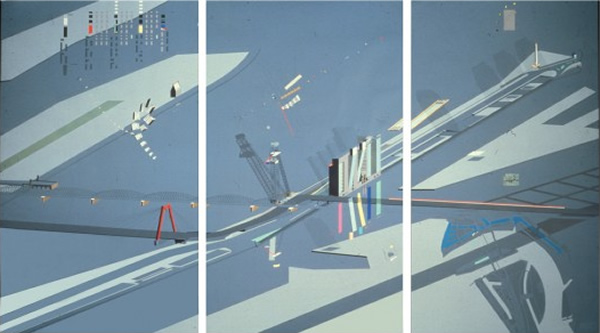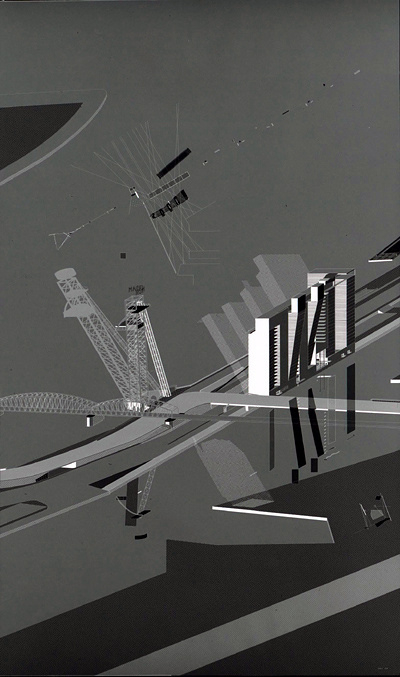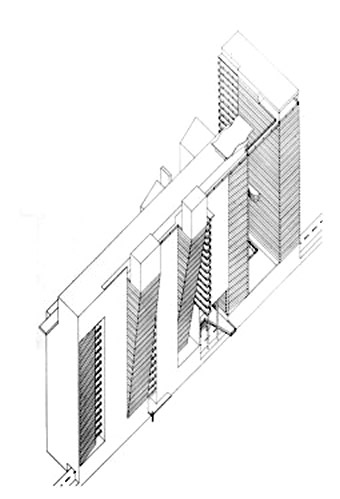My favourite architectural image is on display at the moment. Seeing something 'in the flesh' that you've looked for so long in a book was one of those knee-wobble experiences, a pure hyperkulturemia moment.
It's this:

It's on display as part of the OMA/Progress exhibition currently on at the Barbican. Overall I found the exhibition to be rather disappointing. I am a huge fan of the work of OMA/ Rem Koolhaas but this exhibition seemed to try too hard to downplay the heroic imagery and signature form-making and instead be wilfully as scrappy as possible. In an attempt to counteract the 'starchitect' syndrome and demonstrate the amount of research and the full design process it becomes rather impenetrable. There's much to explore but not much eye candy. Which is why the image of the Boompjes housing project really stands out. It's beautiful.
This has been just about my favourite architectural representation ever since I first saw it in the catalogue of the Deconstructivism exhibition at the MoMA in 1988, curated by Mark Wrigley and Philip Johnson.
It's a triptych created by OMA as a design research project for a housing on the Boompjes in Rotterdam in 1980.
Here's what OMA say about this project on their own website:
At the end of 1980 OMA was asked by the city of Rotterdam to conduct a study of high rise building in the city, and to illustrate the investigations with a planning proposal for a site in the centre. In consultation with the Town Planning Department, a site was selected on the Maasboulevard along near the Maasbridges. We see the angle between the river and the lower side of the grid as a 'hinge' between the city and the river. Here the river is closest to the centre. The shifting of the centre through the injection of gigantic buildings in the second reconstruction makes this point most suitable to take over the role of the 'window' in the disclosing of the riverfront. The site is peculiar. On one hand it is embedded in a network of traffic lanes, like the new suspension bridge across the Maas whose approach makes its way into the city through two inexplicable twists. On the other hand there lies a unique opportunity to connect the river with the city. The city is visible, but hardly accessible; any structure will be noted in passing, at bewilderingly different speeds and angles.
The building and the bridge are designed as an undetachable whole. Built as a composition of towers inserted in a slab, the project carries on the experiments in slaboid mutations and new building types that were done after the war in the bombed areas. It forms a transparent screen along the riverfront. On the riverside the screen acts as a row of stone towers against a glass horizon, introducing a skyline in the Rotterdam skyline, and on the city side it acts as a stone slab with glass towers and slits, that portray pieces of the river. Due to their different angles, the glass surfaces on the city side reflect the light in different directions and mostly they only reflect air and water, not buildings. The building is designed toward the kinetic experience, caused by the passing of the site with different speeds across the bridges and the boulevard: The towers all have a different angle to the slab: some fall backwards, others are contained, others twist away and the steel tower has altogether escaped.
The average height of the building in 72 meters. For a tower this is not so high, for a slab it is (according to Dutch standards). The composition of these elements in this project claims a fair height to be effective in the skyline of the Rotterdam harbour, where the juxtaposition of extremely high constructions with lower city districts is a frequently appearing image.
Now that the city nears completion, the riverfront – more precisely, the so-called Maasboulevard, a curved dike that protects the rest of the city – remains under-exploited and is one of the last frontiers for further development. The two structures for Rotterdam are located exactly at this point; they form a ‘cornerstone’ of the old ‘modern’ centre, and face, across the fault, the multitude of anti-modernist revisions.
This project had a triple purpose: to activate the riverfront; to propose a ‘solution’ for the bridgehead of the old bridge that will become redundant after the inauguration of the new one; and to suggest an apartment building for a site against the old bridge. The site is peculiar: one side is quayside, the other is formed by a riverside highway, one the side of a bridge. It is visible, but hardly accessible; any structure on it will be noted in passing, at bewilderingly different speeds and angles.
There's so much to enjoy in this image - more than you can make out in this small version above, and like all great art rewards patient engagement. It is not a painting, nor is it a traditional architectural drawing, even if it can be read alternately as either. The image mixes and collapses several modes of representation onto one composition, which might be a fairly common concept today but wasn't back in 1980, and owes more to Suprematism than traditional architectural renderings. It is not an image that can be 'read' easily, it does not illustrate the Boompjes proposal but is an exploration, part of the design process. It collapse a huge number of influences and themes onto the space of the drawing. In my opinion it does not represent the project - it is the project.
The central part of the composition in the middle panel is an isometric representation of the site and OMA's proposal, which consists of a slab block articulated by with a number of projecting and slanting towers ("experiments in slaboid mutations"), a Constructivist viewing platform/ tower, and a number of other urban interventions. Extending beyond this is the urban context, with certain landmark elements, such as the Maas river and the two bridges the Willemsbrug and the Spoorbrug. There is also the White House, a Rotterdam landmark as a prototype skyscraper and one of the few buildings left standing after the Nazi bombardment in the Second World War, delineated but not filled in, as our several other nearby tall buildings, shown to provide context. There is also a small drawing of the building plan.

The isometric view of the main building with its five glass tower elements are reflected below, each given its own colour. Viewing this in 1988 I read these as the structure's virtual reflection, its presence in a Gibsonian cyberspace. Thus the drawing shows the proposed building but also its own mediation. The tower element is a pure Constructivist composition inspired directly by El Lissitzky's platform for Lenin. In the right hand panel is a tiny city map, a larger scale plan, and some other unknown elements. Similarly, the left hand panel contains a series of shapes, which I think relate to the programmatic use of each of the four tower, plus some attempts I think to explore the 'kinetic' view of the project from different viewpoints and speeds, again a homage to Suprematism and a similar concept to that of the early work of Zaha Hadid.
![Boompjes housing OMA] (http://www.kosmograd.com/newsfeed/images/boompjes/boompjes_03.jpg)
In the book Rem Koolhaas /OMA by Robert Gargiani, he examines this project as an example of Koolhaas' Contextualist period:
'The concept of Contextualism was critically examined in the project for the complex of the Boompjes in Rotterdam, prepared by Koolhaas in 1980-82 and commissioned by the City Government. The lot is outside the historical centre, on the banks of the Meuse along Maasboulevard, near the Spoorbrug and the Willemsbrug. This area was emblematically chosen by OMA, without any indication from the city, for its character as a residual zone in a content that was even more chaotic and varied than that of the Binnenhof, at the converging point of different sectors of the city that had been razed by bombing during World War II. The area belongs to the category of the Terrains Vagues of Constant, and therefore particularly relevant for the expression of Contextualism without any precise character. The fact that the government was interested in testing "the impact of the high-rise building on the city-scape", also following the success of Delirious New York, allowed Koolhaas to invent a volumetric situation based on that of the skyscrapers of New York, like the Waldorf-Astoria Hotel and Rockefeller Center, specifying a functional program on the models of the New York hotel and the Soviet workers' club. The complex. 72 meters in height and composed of the assemblage of multiple volumes, is configured according to the criteria of Malevich and Ferriss as an abstract edified bulk, "designed from the outside in", as Koolhaas put it.

The other drawings OMA created for this project do not really interest me (apart from a fantastic worms-eye axon of the Constructivist tower, of which more later). They are about building form, concrete proposal. Whereas the isometric triptych, called the Rotterdam Summation in the MoMA catalogue, is about urban appearances, the self-image of the city.
It's clear to see the development of themes in this project with subsequent OMA projects, but the influence of this image upon the realm of architectural representation should also not be underestimated. I shall be going back to see it again at least once before the exhibition ends on 19th Feb 2012.
